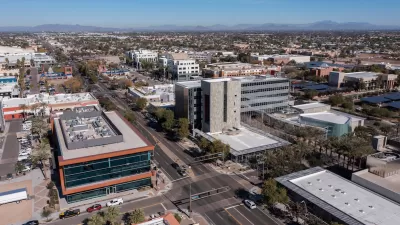The lengths to which the city of Cincinnati should go to attract development investments was up for debate this week.

Nick Swartsell reports on a glut of development subsidies approved by the Cincinnati City Council earlier this week, ranging from an adaptive reuse project that will convert an historic office building to a 262-unit apartment building, a mixed-use development on the riverfront, and many more projects.
"But not everyone is happy about every one of those deals," according to Swartsell. "Some activist groups have objected to the foregone taxes and the lack of affordable housing in the projects. Boosters, however, say they represent valuable opportunities to spur new construction and efforts to rehabilitate significant buildings in the city."
As noted by Swartsell, the largest project is the aforementioned proposal to convert the PNC Tower, built in 1913, into 262 apartments at the cost of $103 million.
"The city has offered a forgivable $2.5 million loan — $1.5 million upfront and another million that will be released later, after the developer makes $9 million worth of facade restorations. Instead of property taxes, the developers would pay into a tax increment financing district created around the building. Eventually, the city would return more than $11 million from that TIF to the developer. The city would keep another $7.75 million. The project has also received federal Historic Preservation Tax Credits."
The Cincinnati Federation of Teachers is one of the leading critics of this development deal, among the others approve this week by the Cincinnati Council. Additional coverage of the deals, and the debate, is also available from an article by Chris Wetterich, written before the council action.
FULL STORY: A Bevy of Cincinnati Development Projects Get Tax Incentives

Alabama: Trump Terminates Settlements for Black Communities Harmed By Raw Sewage
Trump deemed the landmark civil rights agreement “illegal DEI and environmental justice policy.”

Planetizen Federal Action Tracker
A weekly monitor of how Trump’s orders and actions are impacting planners and planning in America.

How Atlanta Built 7,000 Housing Units in 3 Years
The city’s comprehensive, neighborhood-focused housing strategy focuses on identifying properties and land that can be repurposed for housing and encouraging development in underserved neighborhoods.

In Both Crashes and Crime, Public Transportation is Far Safer than Driving
Contrary to popular assumptions, public transportation has far lower crash and crime rates than automobile travel. For safer communities, improve and encourage transit travel.

Report: Zoning Reforms Should Complement Nashville’s Ambitious Transit Plan
Without reform, restrictive zoning codes will limit the impact of the city’s planned transit expansion and could exclude some of the residents who depend on transit the most.

Judge Orders Release of Frozen IRA, IIJA Funding
The decision is a victory for environmental groups who charged that freezing funds for critical infrastructure and disaster response programs caused “real and irreparable harm” to communities.
Urban Design for Planners 1: Software Tools
This six-course series explores essential urban design concepts using open source software and equips planners with the tools they need to participate fully in the urban design process.
Planning for Universal Design
Learn the tools for implementing Universal Design in planning regulations.
Jessamine County Fiscal Court
Caltrans
Institute for Housing and Urban Development Studies (IHS)
City of Grandview
Harvard GSD Executive Education
Toledo-Lucas County Plan Commissions
Salt Lake City
NYU Wagner Graduate School of Public Service




























